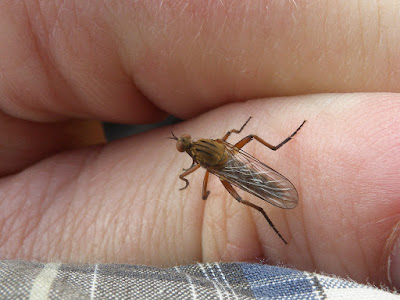I had another very enjoyable day out with the Shropshire Invertebrate Group today. We first headed up to Mason's Bank, a Shropshire Wildlife Trust reserve west of Bishop's Castle. Here, the upland heathland habitats are recovering nicely since the clearance of a conifer plantation in 2008.
Perhaps due to the young age of the heathland, and the stiff breeze at this exposed site, we did not find that many invertebrates. I am sure that this will improve as the site develops, and there were still a few interesting species to see.
One of these was a very large aphid that several of us found in our sweep nets. This was an impressive black aphid, with bright orange legs with black bands, and black markings in the wings. This caused a bit of head-scratching in the field, and it was not until we had returned home that an identification was secured. This is the Greater Black Spruce Bark Aphid Cinara piceae. This species forms large colonies on the undersides of branches and trunks on Spruce (Picea sp.). Their presence at Mason's Bank is presumably related to the previous history of coniferous plantation, and there are other foresty plantations within a few hundred metres of the site.
 |
| Greater Black Spruce Bark Aphid Cinara piceae |
I was also pleased to find a species of Dagger Fly (Empidae) that I had not seen before. This is Empis livida, which can be identified by the brownish abdomen and the pattern of venations in the wing (though this is difficult to see in the pictures below). It is found around hedgerows, and the larvae are also carnivorous in the damp soil and leaf litter.
 |
| Empis livida |
 |
| Empis livida |
After lunch we moved on to Lower Shortditch, a kilometre or so down the road. This is a more established heathland site, with areas of scrub and young woodland, offering a different range of habitats and some comfort from the wind. It actually took us a little while to get onto site, as the brambles by the cars held many species of interest. One of them for me was this pretty micromoth Pammene aurana, a very distinctive tortrix with large orange spots on a chocolate brown forewing. This species is usually found around Hogweed Heraclium sphondylium, and the larvae spin the seeds of the plant together.
 |
| Pammene aurana |
We eventually got away from the brambles, and as the sum came out there was plenty being found in sweep nets and beating trays. There were several of the bumblee mimic Volucella bombylans found around the site. There are a couple of different forms of this hoverfly, one with an orange-red tail (var. bombylans), and this one with a white tail (var. plumata).
 |
| Volucella bombylans var. plumata |
Sweeping around a small pool discovered this Brown China-mark Elophila nymphaeata, an impressive micromoth. This moth has a remarkable life cycle, with their larvae being entirely aquatic. These larvae feed on water plants (eg Potamogeton sp.), mining the leaves before they cut circles out of the leaf and fuse these together to form a case. They then live in this case, presumably using this for protection as they feed and continue to develop.
 |
| Brown China-mark Elophila nymphaeta |
Moving on to bugs, there was a plentiful supply of Gorse Shieldbugs Piezodorous lituratus, though rather than being found on gorse, these were seen to be plentiful on Common Broom Cytisus scoparius. We found them in various stages of their life cycle, from the tiny first instar nymphs through to adults. The sharp-eyed among us also found some eggs on the underside of a seed pod.
 |
| Gorse Shieldbug Piezodorous lituratus |
 |
| Gorse Shieldbug Piezodorous lituratus eggs |
My personal highlight of the day was a small day-flying moth found on the heath itself. It is quite rare that I see a new macromoth species, and finding several of these Small Argent & Sable Epirrhoe tristata was a real treat. These smart little moths can be quite common on open upland habitats, particularly where their foodplant Heath Bedstraw Galium saxatile is found. I saw quite a large number of these moths across the site.
 |
| Small Argent & Sable Epirhoe tristata |
In addition to the species photographed we found a huge range of other interesting species. The most notable of which was a small mining bee Andrena tarsata, which had last been recorded in Shropshire back in 2005. This species uses Tormentil Potentilla erecta,which grows in profusion on the Long Mynd, so perhaps a species for me to look out for around Batch Valley.
So another excellent day out with the group - great company, lots learnt and a friendly and patient welcome for a complete novice such as myself!
No comments:
Post a Comment